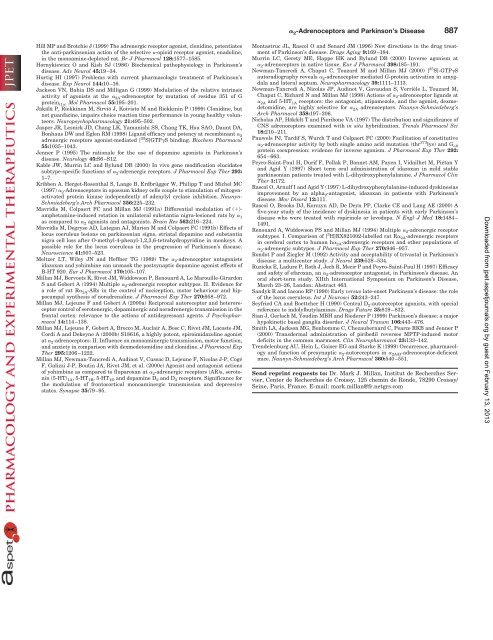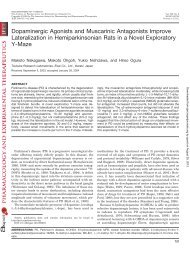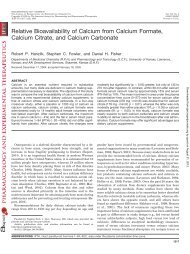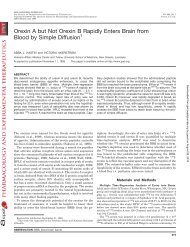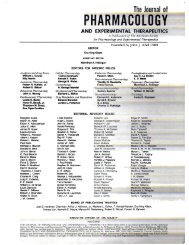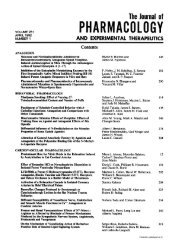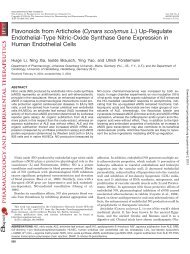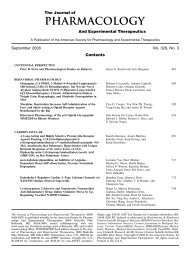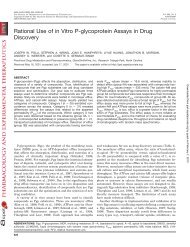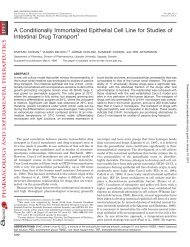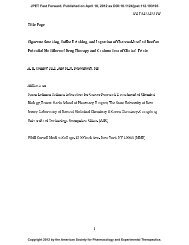Antiparkinsonian Agent Piribedil Displays Antagonist Properties at ...
Antiparkinsonian Agent Piribedil Displays Antagonist Properties at ...
Antiparkinsonian Agent Piribedil Displays Antagonist Properties at ...
You also want an ePaper? Increase the reach of your titles
YUMPU automatically turns print PDFs into web optimized ePapers that Google loves.
Hill MP and Brotchie J (1999) The adrenergic receptor agonist, clonidine, potenti<strong>at</strong>es<br />
the anti-parkinsonian action of the selective �-opioid receptor agonist, enadoline,<br />
in the monoamine-depleted r<strong>at</strong>. Br J Pharmacol 128:1577–1585.<br />
Hornykiewicz O and Kish SJ (1986) Biochemical p<strong>at</strong>hophysiology in Parkinson’s<br />
disease. Adv Neurol 45:19–34.<br />
Hurtig HI (1997) Problems with current pharmacologic tre<strong>at</strong>ment of Parkinson’s<br />
disease. Exp Neurol 144:10–16.<br />
Jackson VN, Bahia DS and Milligan G (1999) Modul<strong>at</strong>ion of the rel<strong>at</strong>ive intrinsic<br />
activity of agonists <strong>at</strong> the � 2A-adrenoceptor by mut<strong>at</strong>ion of residue 351 of G<br />
protein i1�. Mol Pharmacol 55:195–201.<br />
Jäkälä P, Riekkinen M, Sirviö J, Koivisto M and Riekkinin P (1999) Clonidine, but<br />
not guanfacine, impairs choice reaction time performance in young healthy volunteers.<br />
Neuropsychopharmacology 21:495–502.<br />
Jasper JR, Lesnick JD, Chang LK, Yamanishi SS, Chang TK, Hsu SAO, Daunt DA,<br />
Bonhaus DW and Eglen RM (1998) Ligand efficacy and potency <strong>at</strong> recombinant � 2<br />
adrenergic receptors agonist-medi<strong>at</strong>ed [ 35 S]GTP�S binding. Biochem Pharmacol<br />
55:1035–1043.<br />
Jenner P (1995) The r<strong>at</strong>ionale for the use of dopamine agonists in Parkinson’s<br />
disease. Neurology 45:S6–S12.<br />
Kable JW, Murrin LC and Bylund DB (2000) In vivo gene modific<strong>at</strong>ion elucid<strong>at</strong>es<br />
subtype-specific functions of � 2-adrenergic receptors. J Pharmacol Exp Ther 293:<br />
1–7.<br />
Kribben A. Herget-Rosenthal S, Lange B, Erdbrügger W, Philipp T and Michel MC<br />
(1997) � 2-Adrenoceptors in opossum kidney cells couple to stimul<strong>at</strong>ion of mitogenactiv<strong>at</strong>ed<br />
protein kinase independently of adenylyl cyclase inhibition. Naunyn-<br />
Schmiedeberg’s Arch Pharmacol 356:225–232.<br />
Mavridis M, Colpaert FC and Millan MJ (1991a) Differential modul<strong>at</strong>ion of (�)amphetamine-induced<br />
rot<strong>at</strong>ion in unil<strong>at</strong>eral substantia nigra-lesioned r<strong>at</strong>s by � 1<br />
as compared to � 2 agonists and antagonists. Brain Res 562:216–224.<br />
Mavridis M, Degryse AD, L<strong>at</strong>egan AJ, Marien M and Colpaert FC (1991b) Effects of<br />
locus coeruleus lesions on parkinsonian signs, stri<strong>at</strong>al dopamine and substantia<br />
nigra cell loss after O-methyl-4-phenyl-1,2,3,6-tetrahydropyridine in monkeys. A<br />
possible role for the locus coeruleus in the progression of Parkinson’s disease.<br />
Neuroscience 41:507–523.<br />
Meltzer LT, Wiley JN and Heffner TG (1989) The � 2-adrenoceptor antagonists<br />
idazoxan and yohimbine can unmask the postsynaptic dopamine agonist effects of<br />
B-HT 920. Eur J Pharmacol 170:105–107.<br />
Millan MJ, Bervoets K, Rivet JM, Widdowson P, Renouard A, Le Marouille-Girardon<br />
S and Gobert A (1994) Multiple � 2-adrenergic receptor subtypes. II. Evidence for<br />
a role of r<strong>at</strong> R� 2A-ARs in the control of nociception, motor behaviour and hippocampal<br />
synthesis of noradrenaline. J Pharmacol Exp Ther 270:958–972.<br />
Millan MJ, Lejeune F and Gobert A (2000a) Reciprocal autoreceptor and heteroreceptor<br />
control of serotonergic, dopaminergic and noradrenergic transmission in the<br />
frontal cortex: relevance to the actions of antidepressant agents. J Psychopharmacol<br />
14:114–138.<br />
Millan MJ, Lejeune F, Gobert A, Brocco M, Auclair A, Bosc C, Rivet JM, Lacoste JM,<br />
Cordi A and Dekeyne A (2000b) S18616, a highly potent, spiroimidazoline agonist<br />
<strong>at</strong> � 2-adrenoceptors: II. Influence on monoaminergic transmission, motor function,<br />
and anxiety in comparison with dexmedetomidine and clonidine. J Pharmacol Exp<br />
Ther 295:1206–1222.<br />
Millan MJ, Newman-Tancredi A, Audinot V, Cussac D, Lejeune F, Nicolas J-P, Cogé<br />
F, Galizzi J-P, Boutin JA, Rivet JM, et al. (2000c) Agonist and antagonist actions<br />
of yohimbine as compared to fluparoxan <strong>at</strong> � 2-adrenergic receptors (AR)s, serotonin<br />
(5-HT) 1A, 5-HT 1B, 5-HT 1D and dopamine D 2 and D 3 receptors. Significance for<br />
the modul<strong>at</strong>ion of frontocortical monoaminergic transmission and depressive<br />
st<strong>at</strong>es. Synapse 35:79–95.<br />
� 2-Adrenoceptors and Parkinson’s Disease 887<br />
Montastruc JL, Rascol O and Senard JM (1996) New directions in the drug tre<strong>at</strong>ment<br />
of Parkinson’s disease. Drugs Aging 9:169–184.<br />
Murrin LC, Gerety ME, Happe HK and Bylund DB (2000) Inverse agonism <strong>at</strong><br />
� 2-adrenoceptors in n<strong>at</strong>ive tissue. Eur J Pharmacol 398:185–191.<br />
Newman-Tancredi A, Chaput C, Touzard M and Millan MJ (2000) [ 35 S]-GTP�S<br />
autoradiography reveals � 2-adrenoceptor medi<strong>at</strong>ed G-protein activ<strong>at</strong>ion in amygdala<br />
and l<strong>at</strong>eral septum. Neuropharmacology 39:1111–1113.<br />
Newman-Tancredi A, Nicolas JP, Audinot V, Gavaudan S, Verrièle L, Touzard M,<br />
Chaput C, Richard N and Millan MJ (1998) Actions of � 2-adrenoceptor ligands <strong>at</strong><br />
� 2A and 5-HT 1A receptors: the antagonist, <strong>at</strong>ipamezole, and the agonist, dexmedetomidine,<br />
are highly selective for � 2A adrenoceptors. Naunyn-Schmiedeberg’s<br />
Arch Pharmacol 358:197–206.<br />
Nicholas AP, Hökfelt T and Pieribone VA (1997) The distribution and significance of<br />
CNS adrenoceptors examined with in situ hybridiz<strong>at</strong>ion. Trends Pharmacol Sci<br />
18:210–211.<br />
Pauwels PJ, Tardif S, Wurch T and Colpaert FC (2000) Facilit<strong>at</strong>ion of constitutive<br />
� 2-adrenoceptor activity by both single amino acid mut<strong>at</strong>ion (thr 373 lys) and G �0<br />
protein coexpression: evidence for inverse agonism. J Pharmacol Exp Ther 292:<br />
654–663.<br />
Peyro-Saint-Paul H, Durif F, Pollak P, Bonnet AM, Payen I, Vidailhet M, Piétan Y<br />
and Agid Y (1997) Short term oral administr<strong>at</strong>ion of idazoxan in mild stable<br />
parkinsonian p<strong>at</strong>ients tre<strong>at</strong>ed with L-dihydroxyphenylalanine. J Pharmacol Clin<br />
Ther 1:172.<br />
Rascol O, Arnulf I and Agid Y (1997) L-dihydroxyphenylalanine-induced dyskinesias<br />
improvement by an alpha 2-antagonist, idazoxan in p<strong>at</strong>ients with Parkinson’s<br />
disease. Mov Disord 12:111.<br />
Rascol O, Brooks DJ, Korczyn AD, De Deyn PP, Clarke CE and Lang AE (2000) A<br />
five-year study of the incidence of dyskinesia in p<strong>at</strong>ients with early Parkinson’s<br />
disease who were tre<strong>at</strong>ed with ropirinole or levodopa. N Engl J Med 18:1484–<br />
1491.<br />
Renouard A, Widdowson PS and Millan MJ (1994) Multiple � 2-adrenergic receptor<br />
subtypes. I. Comparison of [ 3 H]RX821002-labelled r<strong>at</strong> R� 2A-adrenergic receptors<br />
in cerebral cortex to human h� 2A-adrenergic receptors and other popul<strong>at</strong>ions of<br />
� 2-adrenergic subtypes. J Pharmacol Exp Ther 270:946–957.<br />
Rondot P and Ziegler M (1992) Activity and acceptability of trivastal in Parkinson’s<br />
disease: a multicenter study. J Neurol 239:528–534.<br />
Ruzicka E, Ladure P, Roth J, Jech R, Mecir P and Peyro-Saint-Paul H (1997) Efficacy<br />
and safety of efaroxan, an � 2-adrenoceptor antagonist, in Parkinson’s disease. An<br />
oral short-term study. XIIth Intern<strong>at</strong>ional Symposium on Parkinson’s Disease,<br />
March 23–26, London: Abstract 463.<br />
Sandyk R and Iacono RP (1990) Early versus l<strong>at</strong>e-onset Parkinson’s disease: the role<br />
of the locus coeruleus. Int J Neurosci 52:243–247.<br />
Seyfried CA and Boettcher H (1990) Central D 2-autoreceptor agonists, with special<br />
reference to indolylbutylamines. Drugs Future 35:819–832.<br />
Sian J, Gerlach M, Youdim MBH and Riederer P (1999) Parkinson’s disease: a major<br />
hypokinetic basal ganglia disorder. J Neural Transm 106:443–476.<br />
Smith LA, Jackson MG, Bonhomme C, Chezaubernard C, Pearce RKB and Jenner P<br />
(2000) Transdermal administr<strong>at</strong>ion of piribedil reverses MPTP-induced motor<br />
deficits in the common marmoset. Clin Neuropharmacol 23:133–142.<br />
Trendelenburg AU, Hein L, Gaiser EG and Starke K (1999) Occurrence, pharmacology<br />
and function of presynaptic � 2-autoreceptors in � 2A/D-adrenoceptor-deficient<br />
mice. Naunyn-Schmiedeberg’s Arch Pharmacol 360:540–551.<br />
Send reprint requests to: Dr. Mark J. Millan, Institut de Recherches Servier,<br />
Center de Recherches de Croissy, 125 chemin de Ronde, 78290 Croissy/<br />
Seine, Paris, France. E-mail: mark.millan@fr.netgrs.com<br />
Downloaded from<br />
jpet.aspetjournals.org by guest on February 13, 2013


